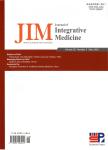Effects and mechanism of Chinese medicine Jiawei Yupingfeng in a mouse model of allergic rhinitis
Effects and mechanism of Chinese medicine Jiawei Yupingfeng in a mouse model of allergic rhinitis作者机构:Department of OtolaryngologyWangjing HospitalChina Academy of Chinese Medical SciencesBeijing 100102China
出 版 物:《Journal of Integrative Medicine》 (结合医学学报(英文版))
年 卷 期:2021年第19卷第4期
页 面:354-361页
核心收录:
学科分类:1007[医学-药学(可授医学、理学学位)] 1006[医学-中西医结合] 1005[医学-中医学] 1002[医学-临床医学] 10[医学] 100602[医学-中西医结合临床]
基 金:financially supported by grants from China Academy of Chinese Medical Sciences Daoyuan medicinal materials valuable Chinese medicine resources sustainable utilization capacity building project (No. 2060302)。
主 题:Chinese medicine Jiawei Yupingfeng Allergic rhinitis Mouse Inflammatory cytokines
摘 要:Objective: Chinese medicine has the potential to modulate allergic rhinitis(AR). There have been studies investigating the treatment efficacy of Yupingfeng San, alone or in combination with other ingredients, in AR, though few have studied the potential mechanisms of these drugs. In the present study, we measured the effects of Jiawei Yupingfeng(JWYPF), a traditional Chinese medicine formula, on mice with ovalbumin-induced AR and explored its underlying mechanism of action.Methods: Forty BALB/c mice were randomly divided into normal control, allergy control and two treatment groups of ten mice each. In the normal control group, mice were sensitized and challenged with saline. The mice in the allergy control and treatment groups were sensitized and challenged with ovalbumin and aluminum hydroxide gel. The treatments of JWYPF and Nasonex were administered intranasally in the AR mice for one week. Several signs of allergic inflammation, such as nasal eosinophils and inflammatory cytokines, were measured to determine the underlying mechanisms.Results: Mice in the JWYPF and Nasonex groups had significantly lower AR symptom scores than those in the allergy control group(the mean differences between JWYPF and the allergy control, and Nasonex and the allergy control were -2.00 ± 0.35 and -2.40 ± 0.32). After treatment with JWYPF and Nasonex, the levels of ovalbumin-specific Ig E and histamine were significantly reduced, as were the levels of interlukin-4 and transforming growth factor-b, while interferon-c levels were increased(all P 0.0001,vs. allergy control). These two treatments also significantly inhibited eosinophil and mast cell infiltration into the nasal cavity but were not statistically different from one-another.Conclusion: JWYPF has a potential therapeutic effect on AR via adjusting the rebalance of T helper 1 and T helper 2.



